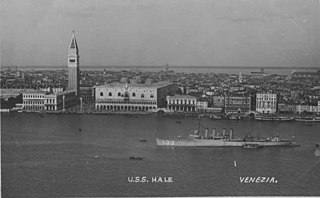
USS Thompson (DD-305), a Clemson-class destroyer of the U.S. Navy named in honor of Secretary of the Navy Richard W. Thompson (1809–1900), never saw action against an enemy. She was the first Navy ship of that name; the second, Thompson (DD-627), named for Robert M. Thompson, served during World War II and the Korean War.

USS Somers (DD-301), a Clemson-class destroyer, engaged in peacetime operations with the Pacific Fleet from 1920 until she was scrapped under the London Naval Treaty in 1930. She was the fourth ship of the United States Navy named for Richard Somers.

USS Hull (DD-7) was a Hopkins-class destroyer, which was a sub-class of the Bainbridge-class destroyer, in the United States Navy, the second ship named for Commodore Isaac Hull.

The first USS Hale (DD–133) was a Wickes-class destroyer in the United States Navy during World War I, later transferred to the Royal Navy as HMS Caldwell (I20). She was named for Senator Eugene Hale.

The third USS Lawrence (DD-8) was a Lawrence-class destroyer, which was a sub-class of Bainbridge-class destroyer, in the United States Navy. She was named for Captain James Lawrence.

USS Fox (DD-234/AG-85) was a Clemson-class destroyer in the United States Navy during World War II. She was the fourth ship named for Gustavus Vasa Fox, Assistant Secretary of the Navy during the Civil War.

USS Humphreys (DD-236/APD-12) was a Clemson-class destroyer in the United States Navy during World War II. She was named for Joshua Humphreys, a pioneer US shipbuilder.

USS James K. Paulding (DD-238) was a Clemson-class destroyer in the United States Navy during the period between World War I and World War II. She was named for former Secretary of the Navy James Kirke Paulding.

The fourth USS Lawrence (DD-250) was a Clemson-class destroyer in the United States Navy during World War II. She was named for James Lawrence.

USS Sinclair (DD-275) was a Clemson-class destroyer in the United States Navy. She was named for Captain Arthur Sinclair.

USS Moody (DD-277) was a Clemson-class destroyer in the United States Navy in commission from 1919 to 1922 and from 1923 to 1930. She was named for Justice William Henry Moody.

USS Henshaw (DD-278) was a Clemson-class destroyer in the United States Navy following World War I. She was named for Secretary of the Navy David Henshaw.

USS Doyen (DD-280) was a Clemson-class destroyer built for the United States Navy during World War I.

USS Stoddert (DD-302/AG-18) was a Clemson-class destroyer in the United States Navy following World War I. She was named for Benjamin Stoddert.

USS William Jones (DD-308), a Clemson-class destroyer in the United States Navy, named for William Jones.

The third USS Woodbury (DD-309) was a Clemson-class destroyer in the United States Navy. She was named for Levi Woodbury.
USS Yarborough (DD-314) was a Clemson-class destroyer in the United States Navy.

USS Wood (DD-317) was a Clemson-class destroyer in service with the United States Navy from 1921 to 1930. She was scrapped in 1931.

The first USS Farenholt (DD-332) was a Clemson-class destroyer in the United States Navy following World War I. She was named for Oscar Farenholt.

The third USS Keppler (DD/DDE-765) was a Gearing-class destroyer in the United States Navy during the Korean War and the Vietnam War. She was named for Boatswain's Mate First Class Reinhardt J. Keppler (1918–1942), who was posthumously awarded the Medal of Honor for "extraordinary heroism" during the Naval Battle of Guadalcanal.



















